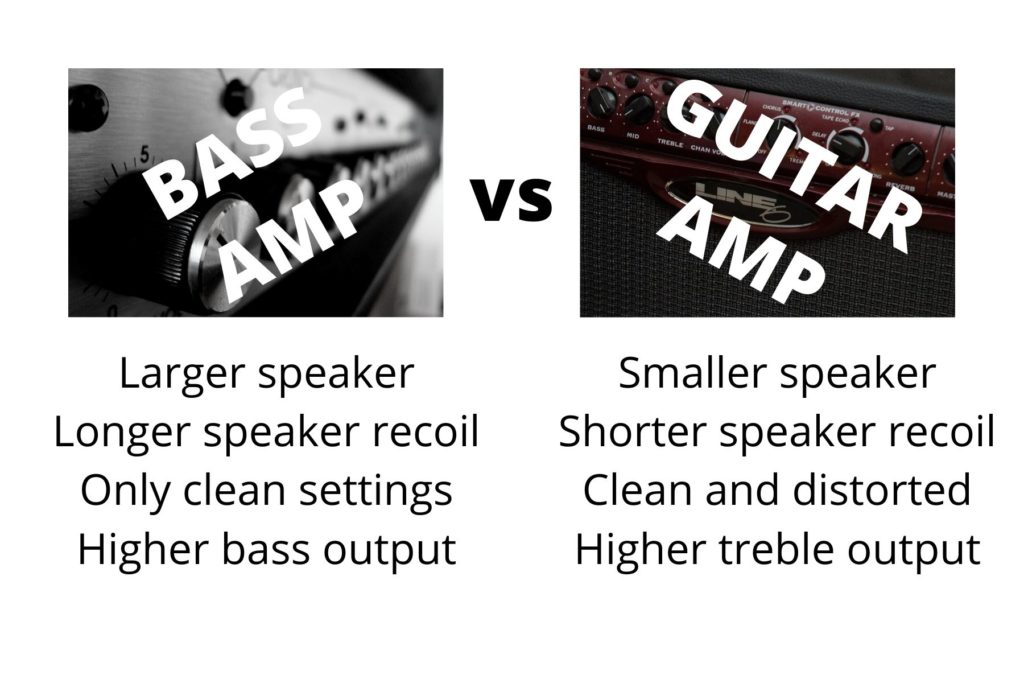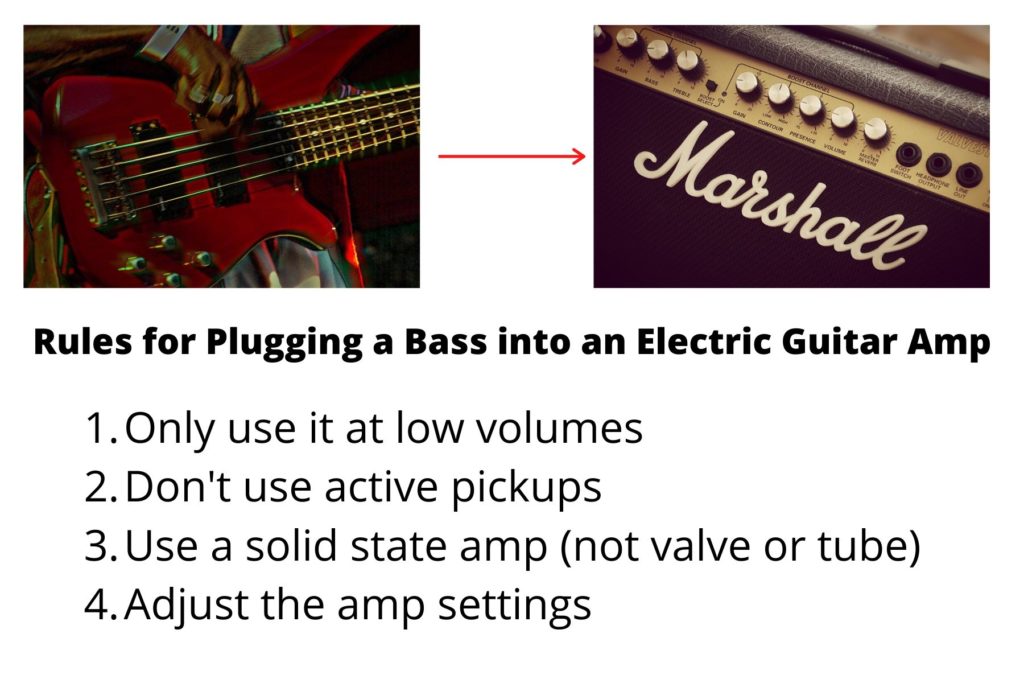So you’re an electric guitar player, but you want to branch out into the world of bass guitars. But. They’re pretty expensive. And, on top of the cost of the bass guitar, you’re wondering if you also need to fork out for a new amp as well.
So do you actually need an amp specifically designed for a bass guitar, or can you just plug it straight into your electric guitar’s amplifier?
In this article, I’ll discuss the differences between electric guitar and bass amps, some rules for using your guitar amp for bass, and a few tips to make your bass sound its best. So let’s get started!
The Quick Answer
It is not recommended to use an electric guitar amplifier with a bass guitar because it can damage the amp especially if used at higher volumes. The risk of damage is greater if a tube (valve) amplifier is used compared to a solid state amplifier.
Electric Guitar Amps vs Bass Amps
So to understand more about using an electric guitar amp for a bass guitar, it’s important to understand the differences between guitar amps and bass amps. Then we can address how to actually use an electric guitar amp for bass.
Differences Between Bass and Electric Guitar Amps
- The overall tone (voicing) is different
- The controls are different
- Bass amps have larger speakers with longer recoil
Let’s talk through each of these points in a bit more detail.

Different Tone (Voicing)
Bass amps and electric guitar amps are designed to work with different instruments, hence, they create a different kind of tone, otherwise known as the voicing of the amp.
Guitar amps have more emphasis on the treble and upper-mid range frequencies than bass amps, which of course have more focus on the bass. This is what makes a bass guitar sound warmer and less sharp and harsh than a standard electric guitar.
Controls
Not all the controls on bass and electric guitar amps are different. Generally, on both types of amps, you’ll get bass, mids and treble controls, or some variants such as contour, EQ, tone or presence.
These allow you to adjust the frequencies of sound that are played out of the speaker. Hence, allowing you to adjust how bright, or warm the tone is.
Bass amps don’t normally have distortion channels like standard guitar amps do.
Speaker Size
Bass amps have much larger speakers than standard electric guitar amplifiers. This is because you need larger speakers to help amplify those low-end bass frequencies. This is because bass frequencies are harder for the human ear to hear than treble frequencies.
Electric guitar amps have smaller speakers because the tone is brighter, so you don’t need as much volume and power.
Electric guitar amps usually have speakers that are between 50 and 200 watts. Bass amps on the other hand, can have power outputs as high as 500 watts.
Guitar amps have shorter recoil times, meaning that the speakers are more likely to blow out than bass guitar amps which can handle much higher volumes.
Is It Possible to Use a Guitar Amp for Bass?
Using a bass with an electric guitar amp is not recommended as there is an increased risk of damage to the amp. However, some bassists will still try it.
Here are some tips to reduce the risk of damage to the amp:
- Only use an electric guitar amp on low volume with a bass guitar
- Do not use a bass guitar with active pickups
- Only use a solid state amp, not a valve or tube amp
- You need to adjust the settings to make the bass sound better
It’s super important that you follow these rules (in particular the first three), otherwise you risk permanently damaging your amp, and your ear drums!

Rule 1: Use Low Volumes
This is very important. If you’re using a bass guitar through an electric guitar amp, then you need to keep the volume low. This will prevent damage to the speakers.
If you turn the volume up, you will encounter an unpleasant tone, with loads of feedback, and if you turn it up too high, they can blow out.
This is why you can’t use a bass guitar through an electric guitar amp when gigging, because you won’t be able to turn the volume up high enough to be heard, without damaging the speakers.
Rule 2: Only Use Passive Bass Pickups
Again, if you don’t want to damage your amp, and your ear drums, you need to follow this rule.
Passive pickups have a lower output (power) than active pickups. This is because active pickups have a battery inside, which boosts the signal.
It’s really dangerous to use active bass pickups with a normal guitar amp, because like turning the volume up too high, it can blow the speakers.
Most bass guitars have passive pickups, and this can work okay (as long as you follow rule number 1), but it’s always worth checking what pickups you have to double check that they are definitely not active.
Rule 3: Only Use a Solid State Amp, Not a Tube (Valve) Amp
It’s also highly recommended that you don’t use a tube or valve amp with a bass guitar.
There are several problems with this:
- Valve amps are very fragile since they contain tubes made of glass. Using a bass guitar can increase the rattling and can cause the tubes to smash.
- They’re difficult to repair since they are so intricate and complicated.
- Valve amps are very expensive. The last thing you want to do, is wreck your valve amp by plugging a bass guitar into it.
Rule 4: Adjust the Settings
If you want your bass guitar to actually sound like a bass, then you’ll need to adjust the settings on your electric guitar amp to reflect this.
Otherwise, the tone will be way too thin, and way too bright, and it just won’t sound like a bass guitar.
Getting the Tone Right
So, how do you adjust the amp settings to make them suitable for a bass guitar?
Well, if your amp has specific controls for the bass, mids and treble, then start here.
- Increase the bass to the maximum level
- Decrease the treble to around 1-2
- Have the mids between 4-6 (but you can play about with this setting)
This will help your bass guitar sound less bright and sharp, and give it a fuller and warmer tone, so it actually sounds like a bass, and not a weird sounding electric guitar.
Some amps also have other controls to contend with:
- Presence: turn this down. It works the same way as treble does. So to decrease the brightness, you want this setting on low.
- Contour: this works the opposite to the mids control. So if you turn the contour up, you’re effectively turning the mids down. Have this between 4-6 to start with, then increase if you need a fuller tone, and decrease if you need it a bit thinner.
- EQ: turn this counter-clockwise to have a similar effect to turning the treble down and increasing the bass settings.
- Tone: turn this counter-clockwise to make the bass louder, and the treble quieter.
- Distortion or gain: you’ll want this on pretty low. Some amps require a bit of gain to actually produce any sound, so turn this to as low as possible so that you actually hear the guitar.
Summing Up
Hopefully now you feel a bit more clued up on using your electric guitar amp for a bass. Here are a few take home messages you should keep in mind.
- Only use the amp at low volumes.
- Avoid using active bass pickups with a standard guitar amp.
- Do not plug a bass guitar into a tube (valve) amplifier.
- You can only really use a guitar amp for bass at home, it won’t sound great for gigging.
- Increase the bass setting on your amp, and decrease the treble to get a better tone.
- Use a clean channel and low distortion/ gain settings.
So there you go! That’s how to use an electric guitar amp with a bass guitar. I hope you’ve found this article helpful, thanks for reading. Here is another article you might find useful:
